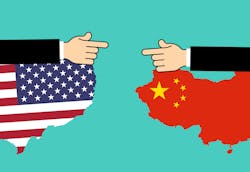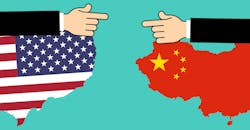SEMI & IPC discuss electronics impact of latest U.S., China trade tariffs escalation
Updated: May 20 at 10 a.m. CT
On Monday (May 14), the rising trade tensions between the United States and China intensified as Beijing said it would raise taxes on almost $60 billion worth of American goods, to which the Trump administration quickly responded to by releasing a new detailed list of $300 billion worth of Chinese imports that would be subject to tariffs of up to 25%.
It was the latest spat between the world's two largest economies, and while President Trump stated Monday that he would meet with China president XI Jinping in Japan during June, Monday's developments certainly raised the confrontation to another level.
"The proposed product list covers essentially all products not currently covered by action in this investigation," the Office of the U.S. Trade Representative United States said Monday. "The proposed product list excludes pharmaceuticals, certain pharmaceutical inputs, select medical goods, rare earth materials, and critical minerals."
The U.S.' list of proposed products to be tariffed includes everything from livestock, to dairy products, to clothing items. It also includes various metals and materials that are used in the production of electronic components, devices, and equipment.
Given that current tariffs are already impacting the electronics and semiconductor markets and that Monday's developments will escalate that further, two prominent industry groups released statements on Monday giving their reaction to the news.
Here is the statement put out Monday by SEMI public policy manager Jay Chittooran. SEMI is an association of companies advocating for the advance the technology and business of electronics design and manufacturing:
"Today, the U.S. Trade Representative (USTR), as part of its Section 301 investigation into China's trade practices, released a list of approximately $300 billion worth of Chinese goods, including a number in the semiconductor supply chain, that would face a tariff of up to a 25%. SEMI is working with members to assess the industry impact and will submit written comments and testify against the tariffs at a public hearing scheduled for mid-June.
SEMI encourages members to review the new list and determine the level, if any, of impact.
Today’s announcement follows last Friday’s tariff hike from 10% to 25% on $200 billion of imports from China. All told, the U.S. already has levied tariffs on $250 billion of Chinese goods that include materials and machines critical to semiconductor manufacturing. The expanded list released Monday would impose tariffs on essentially all imports from China. For its part, China has announced retaliatory tariffs, but more are likely coming.
SEMI has been steadfast in its opposition to these tariffs and other barriers to global commerce. Over the past year, SEMI has submitted numerous written comments and offered testimony on the damaging impact of tariffs to the semiconductor industry. While SEMI strongly supports efforts to strengthen intellectual property protections, we believe that the tariff increases will do nothing to address concerns over China’s trade practices but, instead, harm companies in the semiconductor supply chain by increasing business costs, introducing uncertainty and stifling innovation."
And here is the statement from IPC vice president of global government relations Chris Mitchell. IPC is a trade association whose aim is to standardize the assembly and production requirements of electronic equipment and assemblies:
"In the last week, the U.S. and China have followed through on threats to raise tariffs on more imports from one another’s countries. These tariffs are affecting the global electronics supply chain, increasing costs and uncertainties for companies seeking to remain competitive in the global marketplace. New trade barriers will harm both countries. We urge U.S. and Chinese officials to accelerate negotiations and finalize an agreement that addresses long-standing disagreements, including intellectual property and market access."
On Friday (May 17), MIke Russo, SEMI's VP of global industry advocacy, provided the following statement regarding the situation:
“We continue to monitor what appears to be a deteriorating situation between the U.S. and China related to their ongoing trade negotiations. The escalation in tariffs as well as the recent supply chain executive order and Department of Commerce action against Huawei are cause for increasing concern as those actions disrupt the supply chain and run counter to all-important market access.”
“The globally integrated, complex supply chain that underpins our industry requires the world’s largest economies to lead the way by establishing rules that ensure access to markets and protect IP. Reaching an agreement that is aligned with SEMI’s global trade principles would be mutually beneficial to the two nations as well as our global industry, and we are hopeful that such an agreement can still be reached.”
What are your thoughts on how trade tensions—especially these latest developments—are impacting or will impact the greater electronics industry? Are they impacting your business? Let me know by shooting me an email at [email protected]
About the Author


